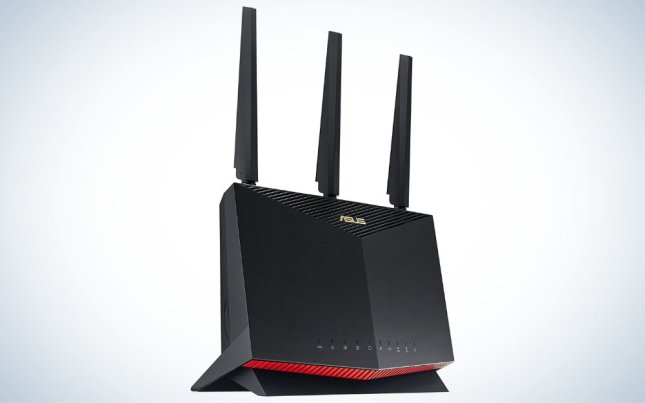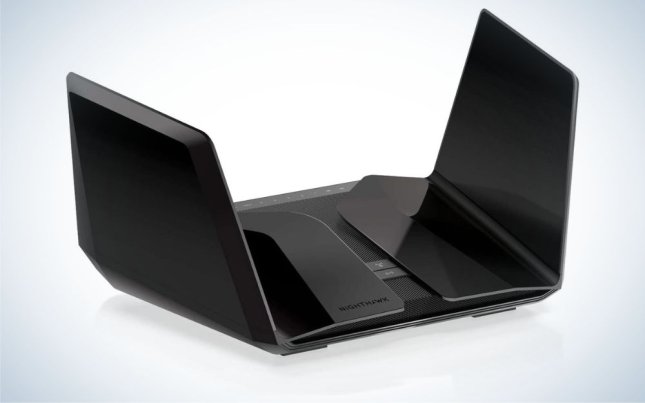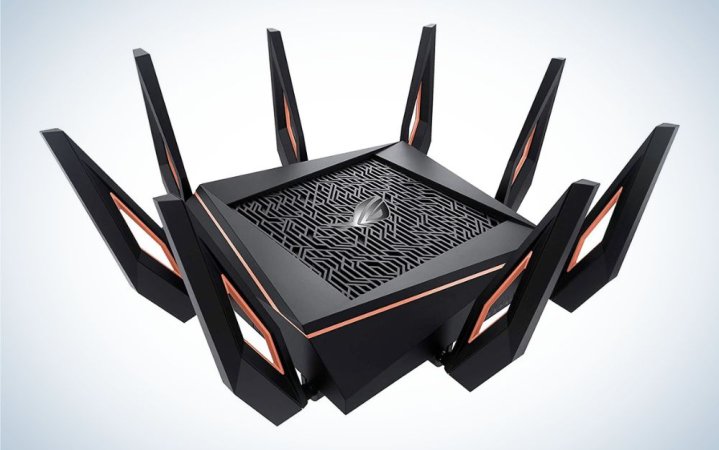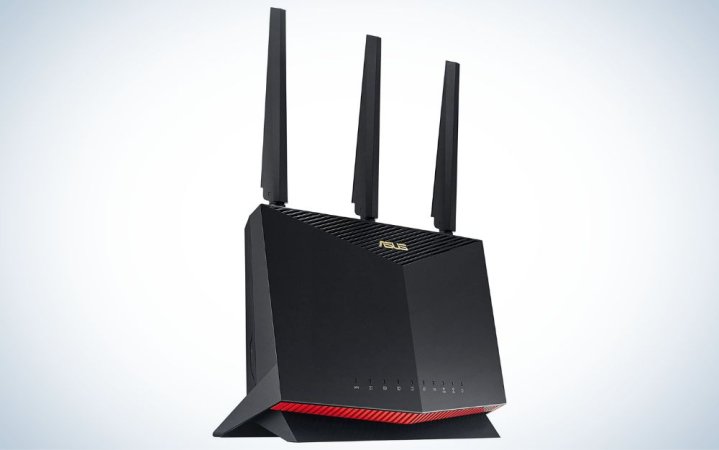We may earn revenue from the products available on this page and participate in affiliate programs. Learn more ›

As millions of people have adjusted to remote work, a reliable home network has become more important than ever—and, therefore, so has a reliable router. A consistent connection can handle Zoom meetings, video uploads, and streaming presentations without buckling under the high bandwidth. Often, when your home network fails to deliver the speeds your ISP promised, a new and improved router can help quite a bit. The stock router you can get when signing up for Verizon Fios pales in comparison to the best routers on the market. If you need a way to make the service work for you, the best routers for Verizon Fios can deliver higher speeds across many more devices and may help as much as upgrading your plan.
- Best overall: Asus ROG Rapture GT-AXE11000
- Best dual-band: Asus RT-AX86U Wi-Fi 6 gaming router
- Best for gaming: Asus AX6000 Wi-Fi 6 Gaming Router (RT-AX88U)
- Best for streaming: TP-Link Archer A20 (AC4000)
- Best WiFi 6: Netgear Nighthawk Wi-Fi 6E Router (RAXE500)
- Best budget: TP-Link Archer A7
How we chose the best routers for Verizon Fios
Before contributing to Popular Science’s commerce team, I covered gadgets and gear, including routers, for sites like TechnoBuffalo, XDA Developers, and CNN Underscored. I’ve set up several routers and mesh networks for work over the years, including many on Fios, which has been my home internet service provider since 2016.
To make our selections, I drew on that experience, as well as PopSci’s many guides to buying the best routers right now. Of course, I also cross-checked each recommendation for compatibility with Fios, considered industry guides, and read under impressions to better understand what’s available.
Understanding Verizon Fios
Fios is the home internet division of Verizon and runs exclusively on fiber-optic cable. Fiber optics use pulses of light to send data through tiny strands of transparent material like glass or plastic, carrying data directly to your device. Fiber’s often considered superior to cable because it’s more resilient to lag and buffering.
Depending on your location, Fios offers up to 940 Mbps download speeds and 880 Mbps upload speeds, which should allow for a very connected home to do lots of streaming for work or play, gaming, and manage a network of smart home devices. Often, the downside to Fios is availability. Though it is available nationally, Fios isn’t available everywhere. You can always go to the Fios website to see if you can get service in your home or to request it.
The best routers for Verizon Fios: Reviews & Recommendations
The best routers for Verizon Fios should be able to handle whatever you throw at them, whether you’re taking all-day video calls, watching 4K movies, or playing video games online. All of these routers offer a substantial upgrade over the standard Fios router, but that performance comes at a premium.
Best overall: Asus ROG Rapture GT-AX11000
Best overall
Next-Gen WiFi
Pros
- WiFi 6E support
- Plenty of ports
- Tri-band support
Cons
- Pricey
Buy it used or refurbished: Amazon
Why it made the cut: Asus loads up on features, including WiFi 6E, RGB lighting, and more with the excellent ROG Rapture GT-AX11000.
Specs
- Speed: 11000 Mbps
- Wired LAN Ports: 4
- USB Ports: 2
- Bands: 3
The Asus ROG Rapture GT-AX11000 has every modern feature that you might want from a top-of-the-line router. Featuring support for WiFi 6E and a plethora of ports, this tri-band router will ensure your network provides fast WiFi to all of your devices without interruption.
The Rapture GT-AX11000 also supports a quad-core CPU to help keep things running smoothly and features that prioritize online gaming for reduced latency and better ping rates. It also features a design that minimizes the distance between the motherboard connectors and the antennas, which helps optimize the signal strength in every direction. In true gaming router fashion, it is covered in RGB lighting, though it isn’t just for show—you can configure the router to glow different colors to indicate network status, performance dips, and more.
If you’re looking to cover a large space, the GT-AX11000 can also serve as a mesh network access point when paired with other Asus routers. It may be overkill for some, but the Asus ROG Rapture GT-AX11000 gives you tremendous coverage over a wide array of high-demand networking scenarios.
Best dual-band: Asus RT-AX86U Wi-Fi 6 gaming router
Best dual-band
A Powerful Two-Channel Router
Pros
- Mesh network support
- Great for gaming
- Easy installation through web browser or app
Cons
- Vertical orientation antennas make for a really tall router
Buy it used or refurbished: eBay
Why it made the cut: The RT-AX86U from Asus provides users with the best features of WiFi 6 and more.
Specs
- Speed: 5700 Mbps
- Wired LAN Ports: 4
- USB Ports: 2
- Bands: 2
If you’re looking for a powerful router that provides an outstanding balance of speed, technology, and features, the Asus RT-AX86U is tough to beat. This dual-band router features WiFi 6, four Gigabit Ethernet ports, and supports mesh networking, so you can easily create a whole-home WiFi network that reaches every room of your home.
The Asus RT-AX86U also supports a mobile app to easily control settings, three amplified antennas, beamforming, and adaptive QoS (Quality of Service), which lets users prioritize specific network traffic, like streaming video and gaming. Speaking of gaming, the router includes a dedicated gaming port that automatically prioritizes any wired devices connected to it. If you play online multiplayer games, this is a great way to ensure you get the fastest, most consistent connection.
Best for gaming: Asus AX6000 Wi-Fi 6 Gaming Router (RT-AX88U)
Best for gaming
No-Lag Gaming
Pros
- 8 wired LAN ports
- Supports WiFi 6
- Powerful security features
Cons
- Expensive
Buy it used or refurbished: eBay
Why it made the cut: The Asus AX6000 offers wide coverage, up to 6 Gbps bandwidth, and advanced features like QoS for no-lag gaming.
Specs
- Speed: 6000 Mbps
- Wired LAN Ports: 8
- USB Ports: 2
- Bands: 2
Game consoles and computers require a strong, stable connection, so it makes sense to wire them up if you can. The Asus AX6000 offers a whopping eight Gigabit Ethernet ports so that you can wire up every nearby console and gaming PC without an issue. For everything else, the dual-band router can move up to 6 Gbps bandwidth, covering a 5,000-square-foot home. It’s a router for a big home network.
The AX6000 also offers advanced features, including AiProtection Pro, which blocks malicious websites and protects your devices from malware and spam. If the system detects that a device has been compromised, it will prevent your device from making an outbound connection to transmit your sensitive information.
Finally, the AX6000 features adaptive QoS and prioritizes specific devices, like your game consoles and PC. That way, your games will still run smoothly if your network gets temporarily overloaded.
Best for streaming: TP-Link Archer A20 (AC4000)
Best for streaming
Binge Watch
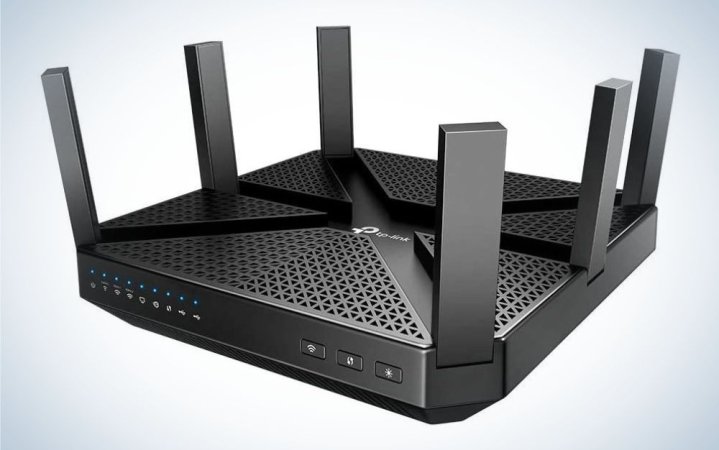
Pros
- Tri-band
- Beamforming and MU-MIMO support
- Built-in antivirus
- Companion app and Amazon Alexa support
- Very affordable
Cons
- No WiFi 6 support
Buy it used or refurbished: eBay
Why it made the cut: The TP-Link Archer A20 is a great router for home with lots of devices thanks to its three frequency bands, four Gigabit Ethernet ports, and enough bandwidth to transmit 4 Gbps of data.
Specs
- Speed: 4000 Mbps
- Wired LAN Ports: 4
- USB Ports: 2
- Bands: 3
For those who spend nights and weekends binge-watching shows on Netflix and HBO Max, the TP-Link Archer A20 should be on your wishlist. The tri-band router supports up to 4GB bandwidth and four Gigabit Ethernet ports, giving users plenty of flexibility to plug in TVs, gaming consoles, and set-top boxes. The Archer A20 also features a 1.8 GHz processor, 512GB of RAM, which helps keep everything running smoothly. It also features “range boost” technology that provides a more consistent, lag-free connection in the far corners of your home.
The TP-Link Archer A20 also supports beamforming technology, which focuses wireless signals toward a specific receiving device. It also features MU-MIMO, or “multi-user, multiple-input, multiple-output” technology to facilitate communication with multiple devices simultaneously. These features make the Archer A20 great for homes full of streaming devices, ensuring no one has to suffer through long bouts of buffering.
Best WiFi 6E: Netgear Nighthawk Wi-Fi 6E Router (RAXE500)
Best WiFi 6E
WiFi of the Future
Pros
- Can connect up to 60 devices
- Supports up to 10.8 Gbps bandwidth
- Supports new 6 GHz band
Cons
- Expensive
Buy it used or refurbished: eBay
Why it made the cut: If you want to prepare for the future of WiFi, the Netgear Nighthawk WiFi 6E offers 6 GHz support, which will open the door for speedy close-range connections in new devices soon.
Specs
- Speed: 10800 Mbps
- Wired LAN Ports: 4
- USB Ports: 2
- Bands: 3
Featuring support for the new 6 GHz band and coverage of up to 3,500 square feet, the Netgear Nighthawk RAXE500 is one of the most future-proof routers you can buy right now. The WiFi 6E router supports up to 10.8 Gbps bandwidth and a whopping 60 devices, perfect for homes with multiple smart home gadgets. It includes four Gigabit Ethernet ports, a single 2.5G Multi-Gig port for supporting speeds between 10 Mbps to 2.5 Gbps, and a quad-core 1.8 GHz processor with 1GB of RAM. There’s also a Nighthawk app for easy setup and access to parental controls and advanced security features to keep your household protected. Fittingly, Netgear’s futuristic router features a futuristic design, giving it a sleek look to match its powerful features. These are just a few of the reasons Netgear routers consistently rank among our top picks.
Best budget: TP-Link Archer A7
Best budget
Budget Speed
Pros
- Great coverage for the price
- Up to 1750 Mbps of bandwidth
- App support for parental controls
Cons
- No beamforming or MU-MIMO
- No WiFi 6 support
Buy it used or refurbished: eBay
Why it made the cut: The TP-Link Archer 7 can cover a 2,500-square-foot home, supports up to 1.75 Gbps, and has an app for deep parental controls.
Specs
- Speed: 1750 Mbps
- Wired LAN Ports: 4
- USB Ports: 1
- Bands: 2
The TP-Link Archer A7 is impressive for a sub-$100 router. It supports up to 1.75 Gbps of bandwidth across 2,500 square feet. This gives users plenty of flexibility to stream over WiFi and hardwire devices that might benefit from a more consistent connection, like a PC or gaming console. The TP-Link Archer A7 also features an app for more granular control over the experience and TP-Link OneMesh support, allowing users to quickly set up a mesh network for whole-home coverage. Unfortunately, the Archer A7 doesn’t support more advanced features like beamforming and MU-MIMO, but the router still offers plenty of value for the price.
Things to consider when buying the best routers for Verizon Fios
Like most internet service providers, Verizon will happily provide you with a router, which doesn’t require an extra fee on your monthly bill. There’s nothing that says you have to use that router, though. In fact, if you’re willing to pay some money upfront, the best routers offer a much better range and support for more devices.
Technically, any router should be compatible with Verizon’s internet hookup. In order to make sure you can get the most out of Fios’ best plan, we looked for routers that can support up to 1 Gbps of bandwidth. We also considered dual-band and tri-band routers that support more recent WiFi 5 and WiFi 6 standards.
Picking the best routers for Verizon Fios can get complicated quickly. Router specs lean heavily on industry jargon. It can be confusing and frustrating for even the most seasoned technophiles. We’ll walk you through the basics so you can pick the right router for your home setup.
Speed and wireless protocol
If you’re going to pay for gigabit internet, you’ll want a router that can take advantage of those speeds. Otherwise, you’re wasting money paying for a service plan you can’t use. If possible, we recommend buying a router with a maximum bandwidth well over the top speed you should receive from your plan. This gives you some flexibility if you decide to upgrade to a faster plan down the road.
You should also pay close attention to what wireless-fidelity protocol your router supports. There are many versions of WiFi, which are noted by various wireless protocols or, more recently, by the numbered WiFi standard. The protocol determines your router’s range and throughput, which measures data speeds on your local network, along with other updates and optimizations. The wireless protocol is written out as the number 802.11, followed by a string of numbers and letters. (You really only need to worry about the letters.) The WiFi standard, which comes in simpler variations like “WiFi 5” and “WiFi 6,” indicates the same set of specs and optimizations.
Newer, more expensive routers are usually capable of supporting the newest versions, WiFi 6 and WiFi 6E, but you will also likely find older models out there limited to older, slower versions. Networking standards are backward compatible, so a WiFi 6 router will connect to devices designed with older WiFi standards in mind. Here’s a little breakdown of what the more recent standards offer:
11ax (WiFi 6E): WiFi 6E opens support for the 6 GHz band, which promises even faster speeds and less network congestion over short distances. Once WiFi 6E becomes more widespread across home networks and personal devices, you should never run into buffering during a Zoom call again.
11ax (WiFi 6): WiFi 6 is the newest standard and delivers speeds up to 10 Gbps, which not many devices and internet connections support. WiFi 6 also features improvements that help it maintain higher speeds across many devices at once. Previous WiFi generations often struggle to stay speedy when several devices are streaming simultaneously. For more on the basics of WiFi protocols, check out our WiFi 6 explainer.
11ac (WiFi 5): This is the standard found in most modern routers and supports speeds up to 3.5 Gbps.
11n (WiFi 4): This is the slowest standard and supports speeds up to 600 Mbps. It was the first to allow both 2.4 GHz and 5 GHz frequencies (more on that below).
If possible, we recommend buying a router that supports one of the newest WiFi standards. Not only will you get the best possible connection, but WiFi 6 routers are better equipped to handle congested networks, which often slows down home networks.
Frequency bands and channels
Frequency bands are a range of radio wavelengths that transmit data over a wireless spectrum. With regard to wireless routers, frequency bands are effectively communication channels for your router to transmit data between your modem and devices.
Most routers feature 2.4 GHz and 5 GHz frequency bands; the higher the frequency, the faster the data transmission rate. Unfortunately, higher frequency bands feature shorter signal ranges, so you need to be closer to your router for the fastest, most reliable connection.
Using 2.4 GHz frequencies sends data a little slower, but offers a better range (150 indoors and 300 feet outdoors). At 5 GHz, data moves faster, over a shorter range. The connection is also more susceptible to interference from walls and other solid objects. New high-end WiFi 6E routers also offer a third frequency band, 6 GHz, which offers even faster speeds, at the expense of stability and range.
Most routers feature either dual-band or tri-band radio functionality, giving your devices either two or three channels to make a connection. Dual-band routers usually feature a 2.4 GHz band and 5 GHz band, ensuring they can connect to any WiFi device. Tri-band routers usually add a second 5 GHz channel, minimizing congestion over the faster frequency.
We recommend a tri-band router for large home networks with many devices that stay connected to the internet around the clock. The extra band will allow more devices to connect to your network without any noticeable dips in speed. Be warned: Tri-band functionality is a luxury feature normally reserved for more expensive routers.
Range
More powerful routers can not only handle more devices and meet newer standards, but they also push their wireless signals further. WiFi signals are at their strongest when you are close to a router, with no physical objects getting between it and your device. Start moving away, or putting walls and doors between you and the router, and your connection will start to degrade. High-end routers often offer a higher maximum range, which, in turn, leads to more stability at longer distances.
Buying a router with a higher maximum distance can improve signal strength in your home, but it isn’t always the best solution. If you’re having trouble getting a connection in a specific room or area of your home, a WiFi extender can boost your signal just enough to improve that specific issue. If you need to cover a very large area, or experience connection issues even when you’re relatively close to your router, you may benefit from using a mesh WiFi system, which generates WiFi from multiple devices.
Before buying any new gear, you should try repositioning your router to a centralized location in your home, on an open shelf away from any walls. (Don’t hide your router in a cabinet or TV stand!) Depending on the situation, you may find that optimizing your setup improves things enough to make an upgrade superfluous. Also, replacing your router won’t help that much if you’re hiding it in a closet.
Connectivity
In the age of WiFi, relying on an Ethernet port might seem old school, but a wired connection provides a consistent, uninterrupted connection at the highest possible speed. As such, we think it’s important to get a router with plenty of additional Ethernet ports so you can connect your most important, bandwidth-hungry devices directly. (I use Ethernet for my PlayStation 5 and Apple TV, for example.) Modern routers typically offer four Ethernet ports, so you may not have to look too hard. Still, we thought it was important enough to highlight, particularly if you plug in your computer for work.
FAQs
Yes, it’s possible to use any modern router on Verizon Fios without any limitations. Verizon does not specify any prerequisites for using a third-party router. That said, you have to use Verizon’s modem.
That depends. Using Verizon’s router is certainly the easiest way to set up internet for most new Fios customers because the company technician will set up your router for you when it sets up your service. That said, you may not get the highest possible speeds allowed by your plan if you have a large home, an older home with thick walls, or a large number of wireless devices connected to your home network. The upfront cost of purchasing your router may be high, but chances are you will save money in the long run.
Routers, like all technology, eventually become obsolete; you will eventually need to replace a very old router. It’s very rare that you’ll need to replace a router before they break since new wireless standards always incorporate support for older versions. That said, we’d recommend checking in to consider an upgrade every five years or so. There is no hard and fast rule, but a five-year cadence will ensure you always have something supporting the latest WiFi advancements.
Routers also break down like anything else and, over time, might produce slower speeds, a reduced range, and other issues. It’s difficult to diagnose any one problem, but if your router isn’t back to its old self after a reboot, you might want to consider upgrading.
Final thoughts on the best routers for Verizon Fios
- Best overall: Asus ROG Rapture GT-AXE11000
- Best dual-band: Asus RT-AX86U Wi-Fi 6 gaming router
- Best for gaming: Asus AX6000 Wi-Fi 6 Gaming Router (RT-AX88U)
- Best for streaming: TP-Link Archer A20 (AC4000)
- Best WiFi 6: Netgear Nighthawk Wi-Fi 6E Router (RAXE500)
- Best budget: TP-Link Archer A7
No matter which router you choose, it should provide a consistent connection that doesn’t buckle under the demands of modern living. There’s enough to stress over while working remotely, and we don’t want your internet to be one of them. Whether you go with a 1 Gbps plan on Verizon Fios or something a little slower, the above routers will ensure your WiFi can handle back-to-back video meetings, high-resolution media, and streaming your favorite shows on Netflix, Disney+, or MAX, etc.

